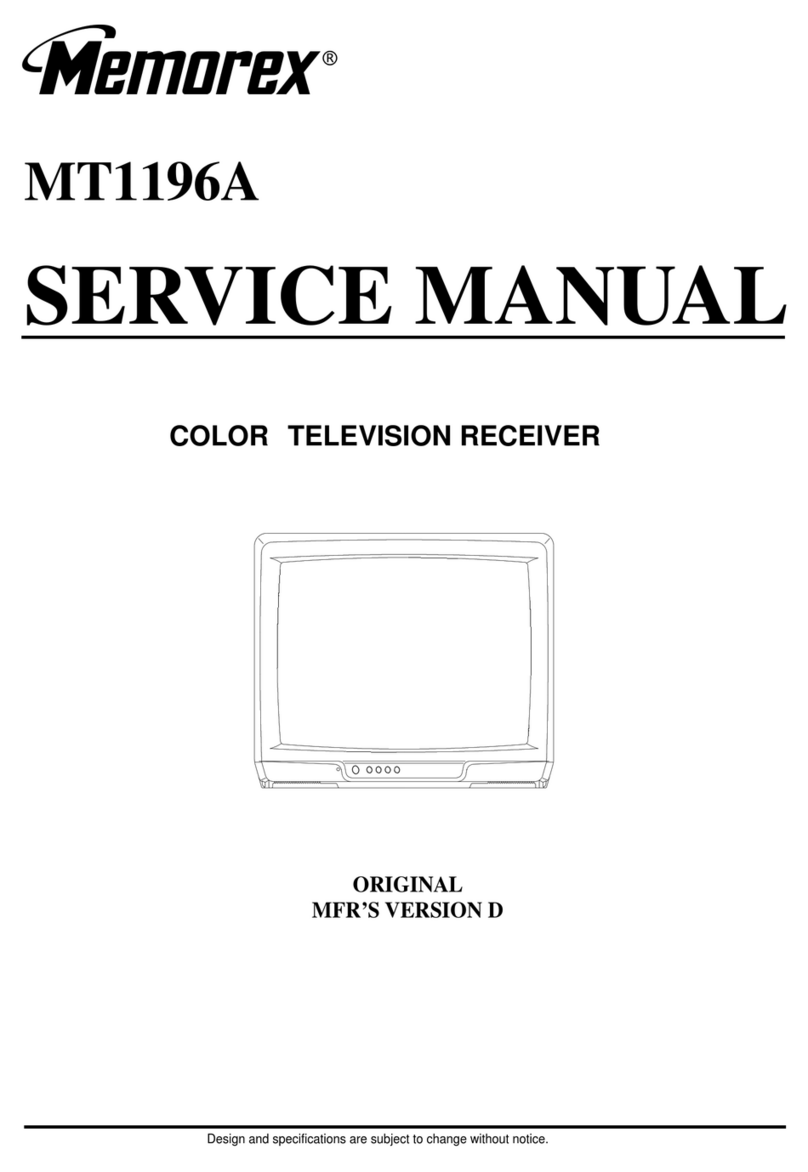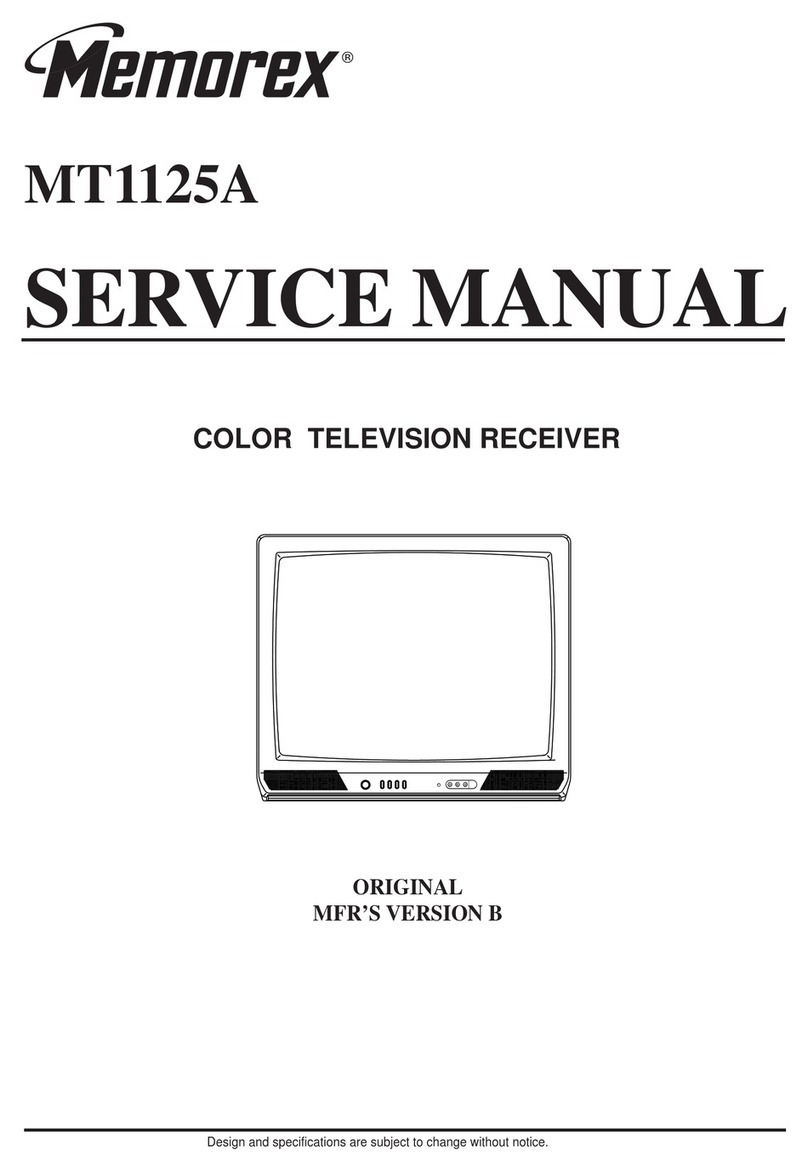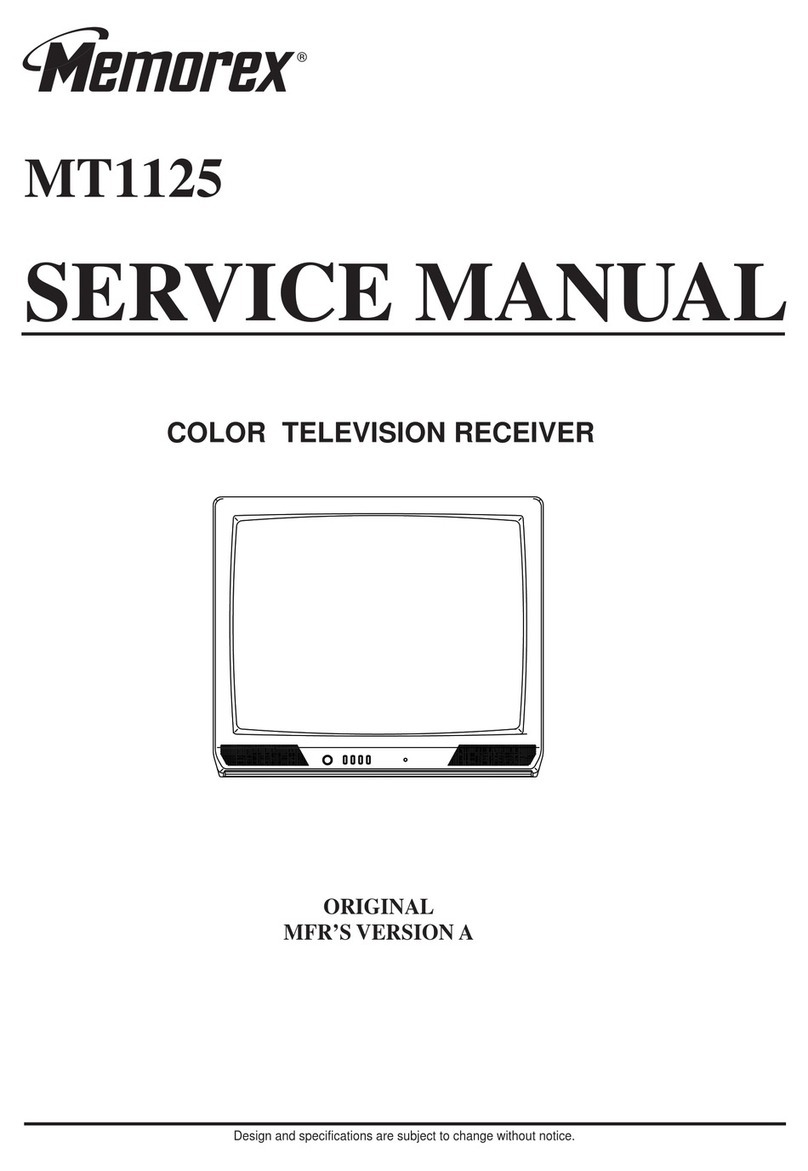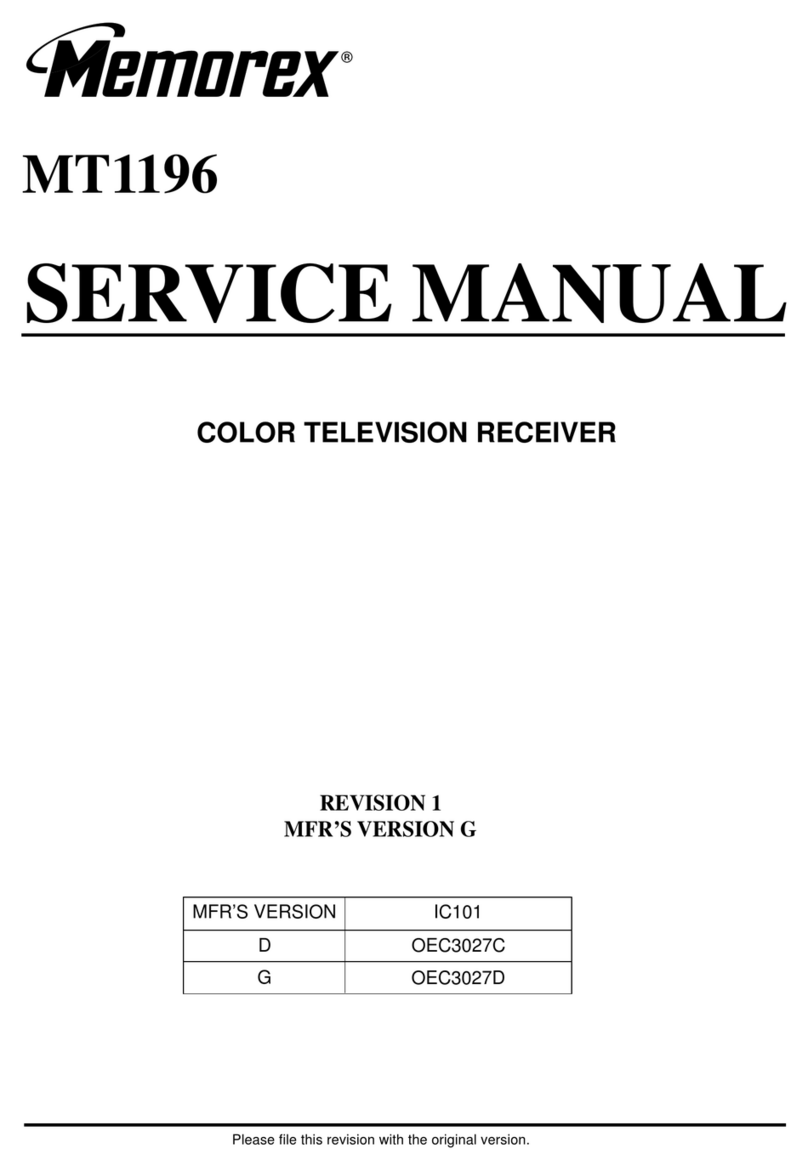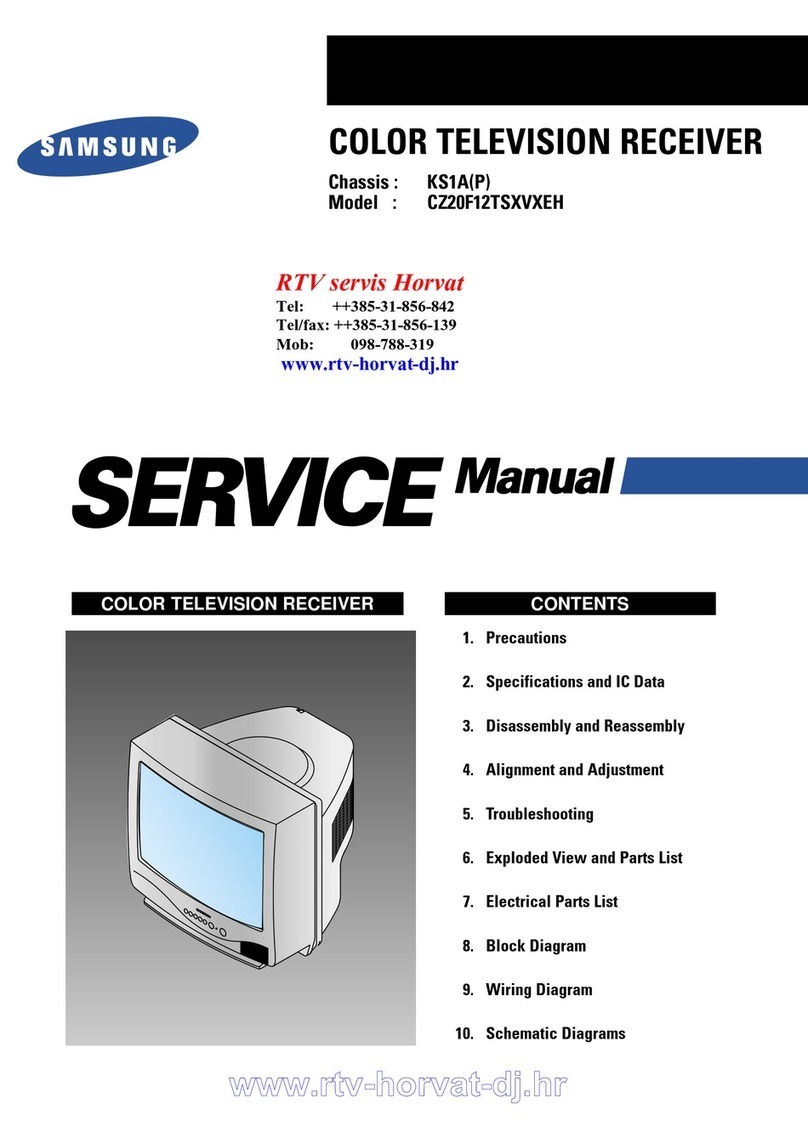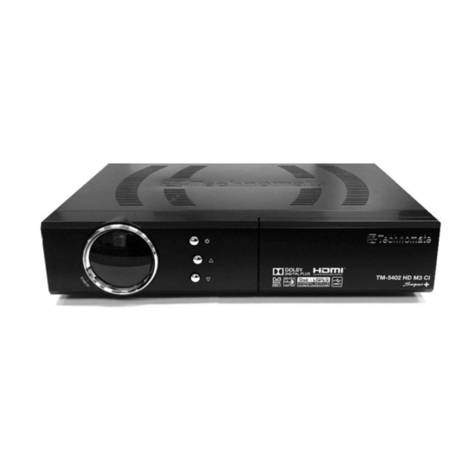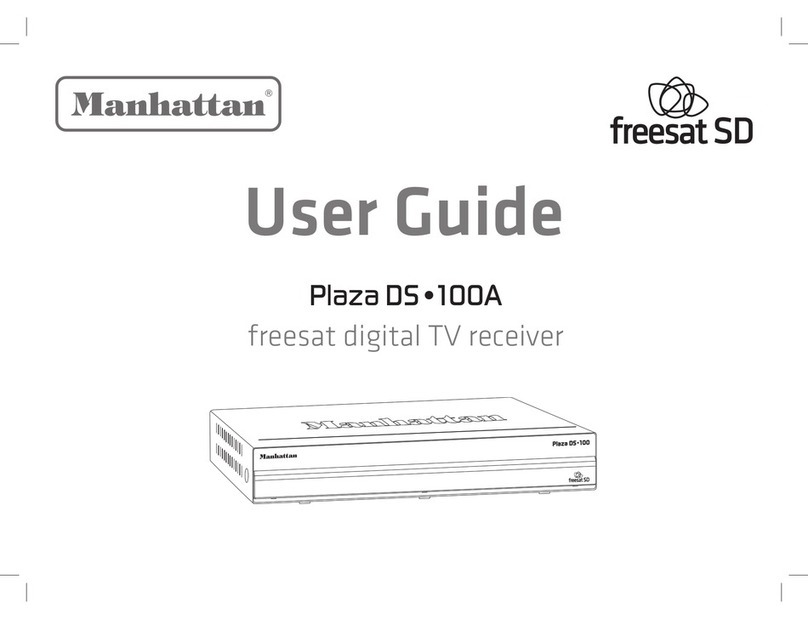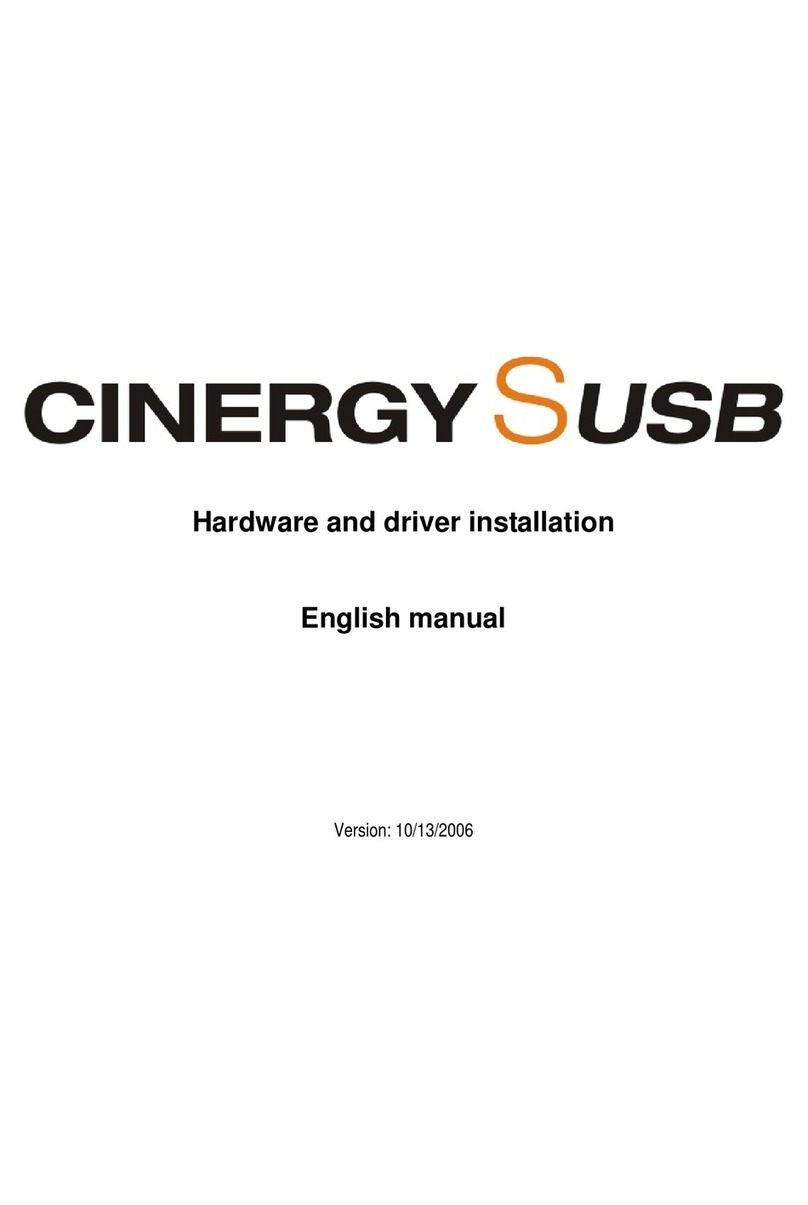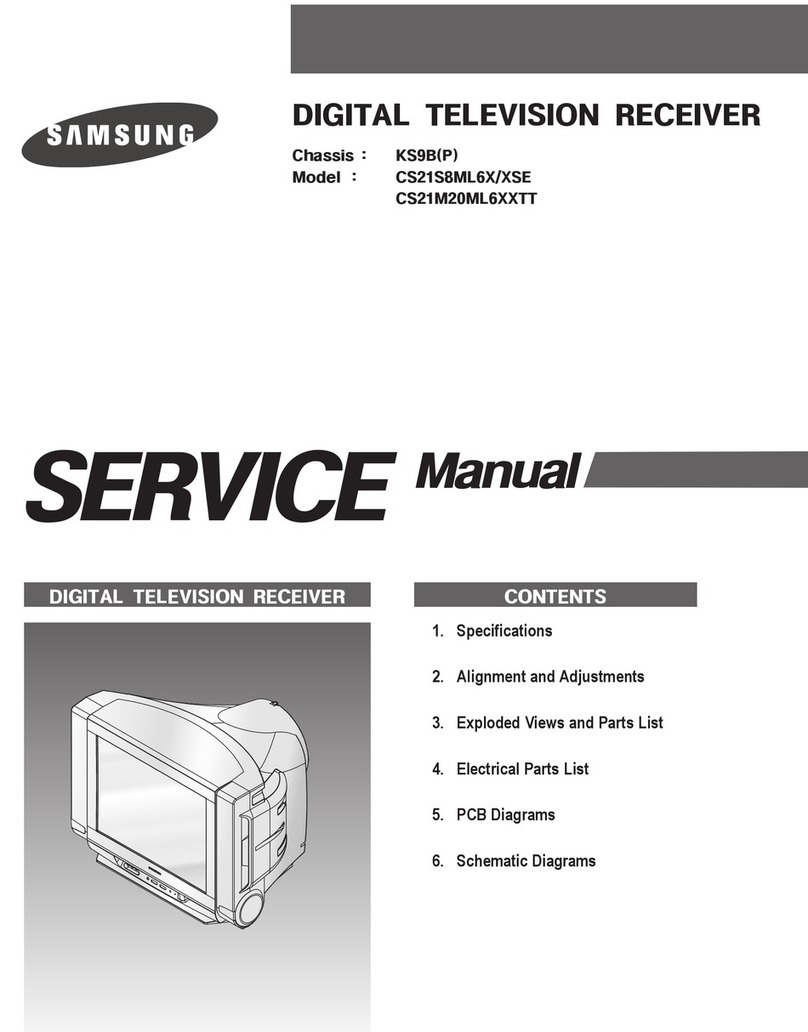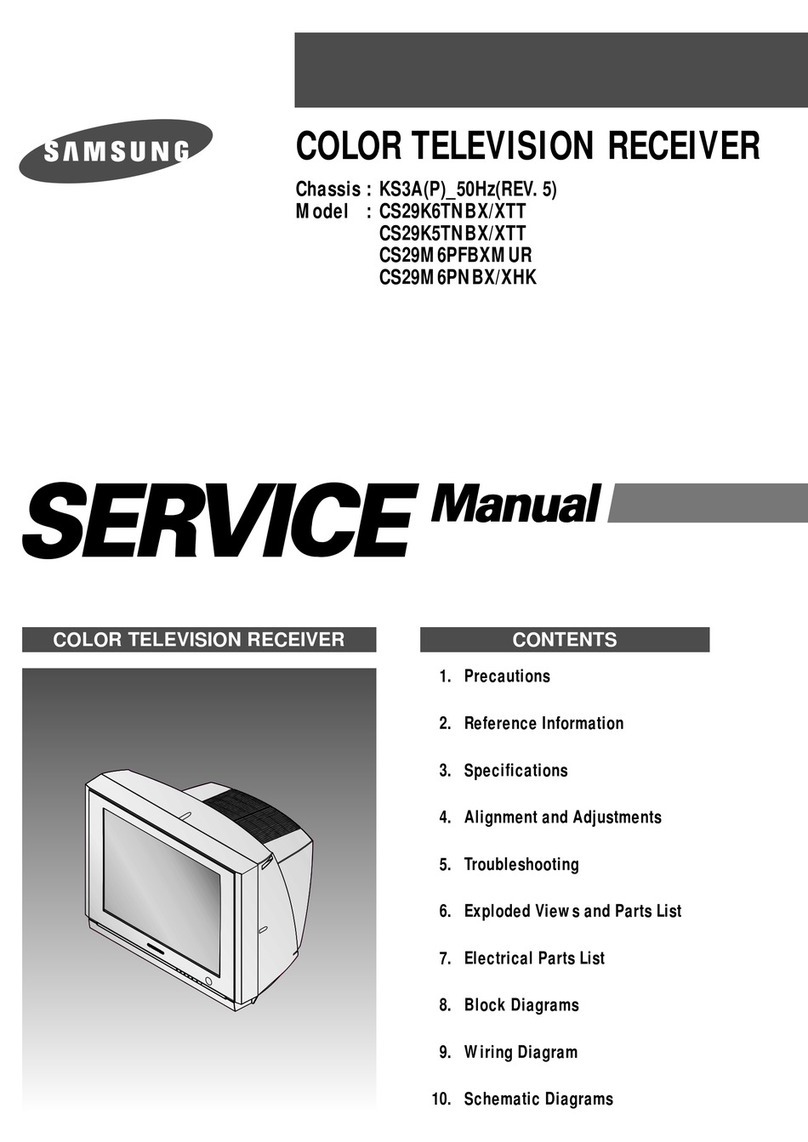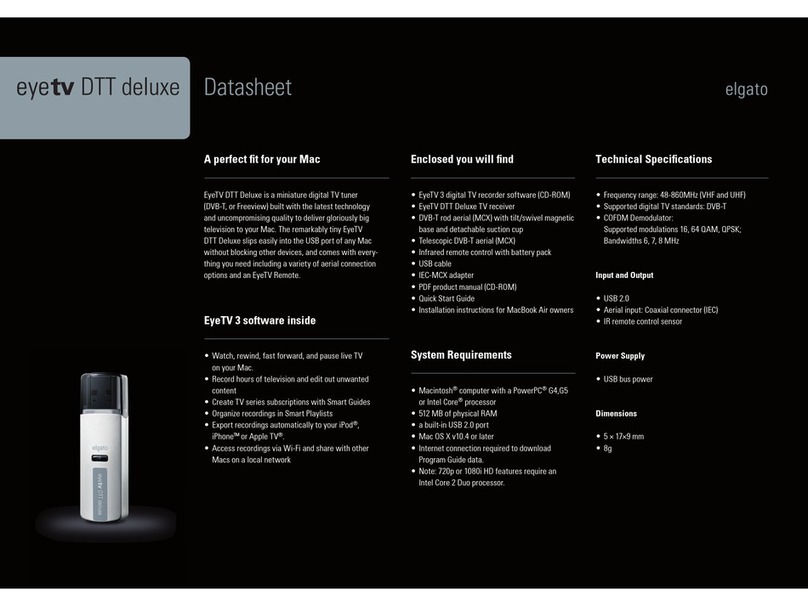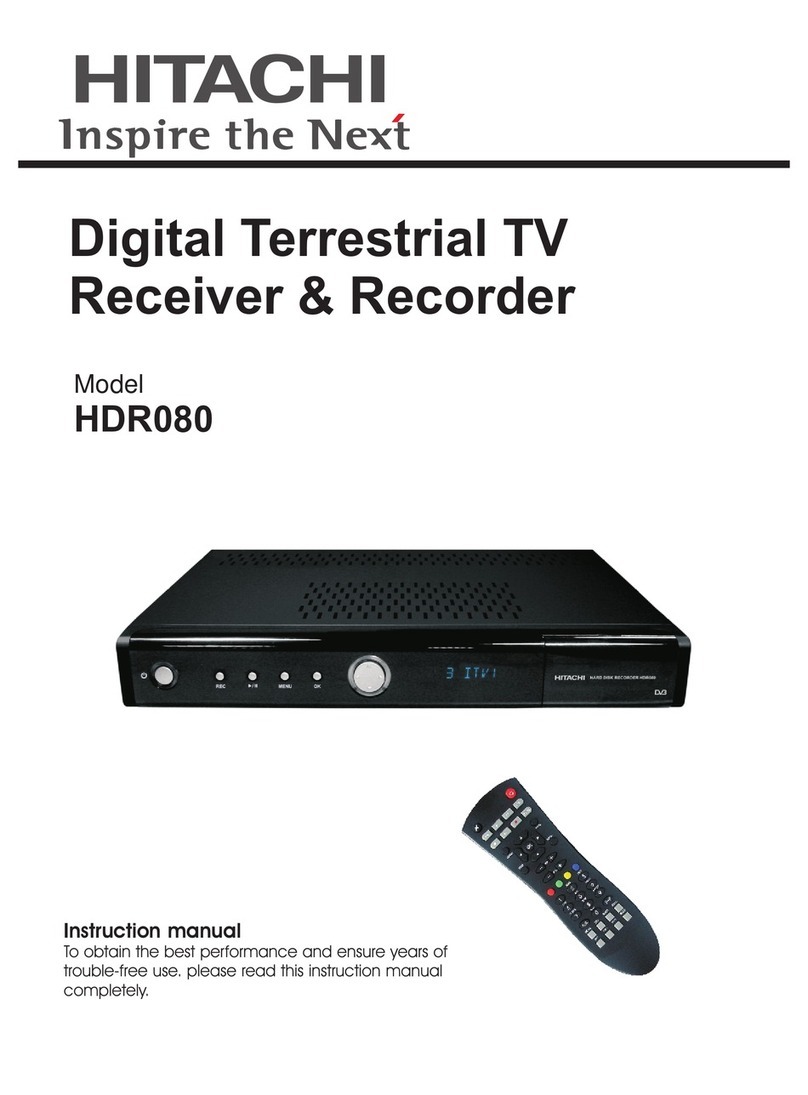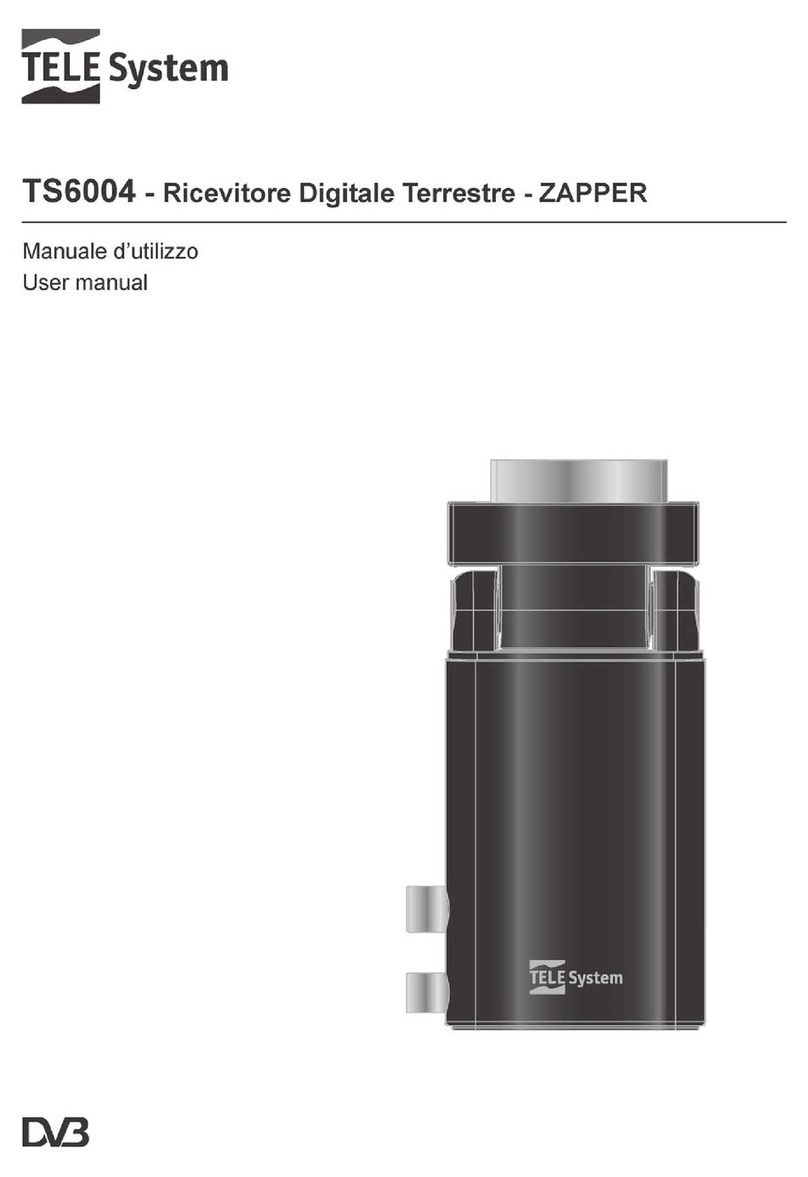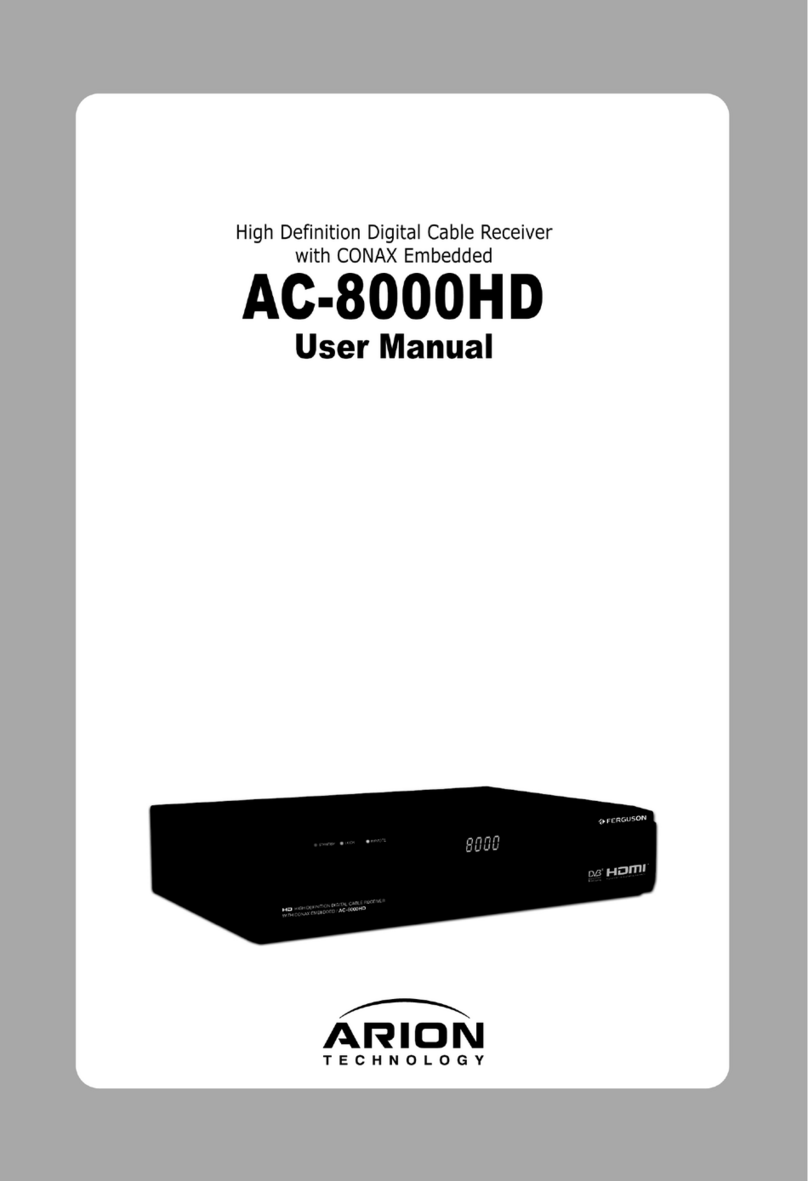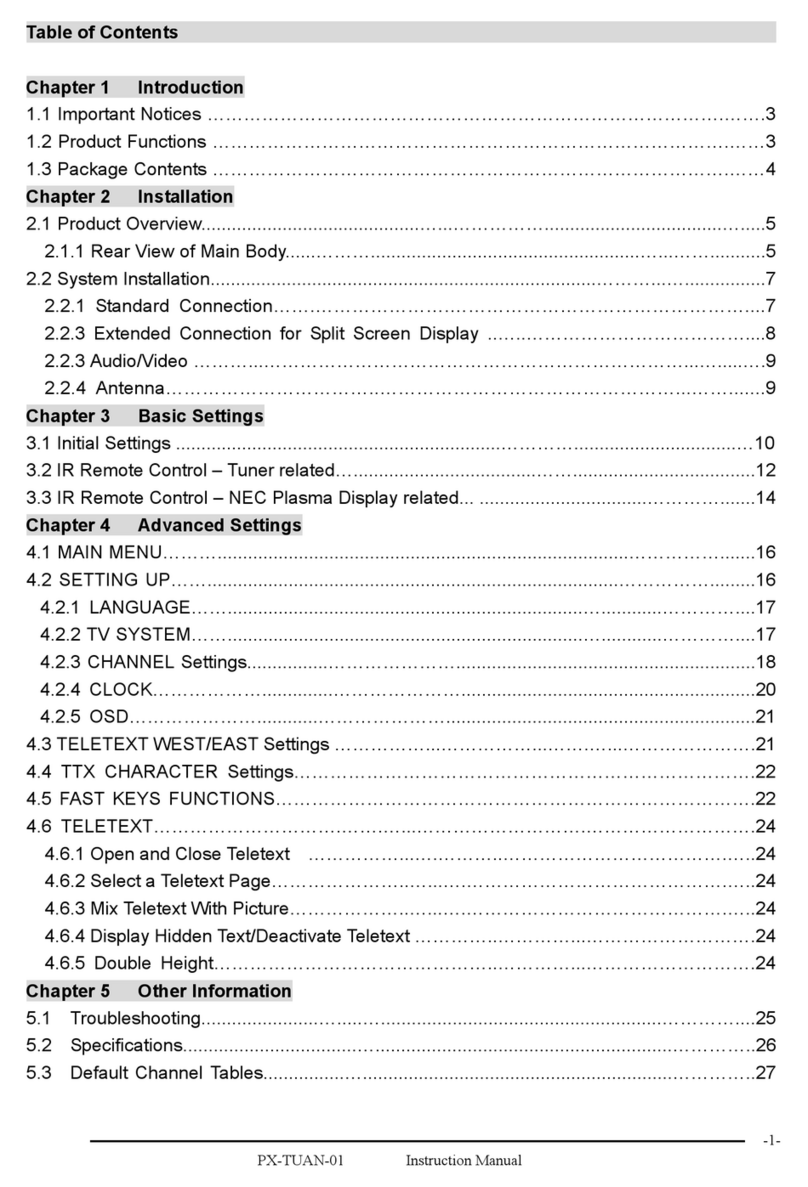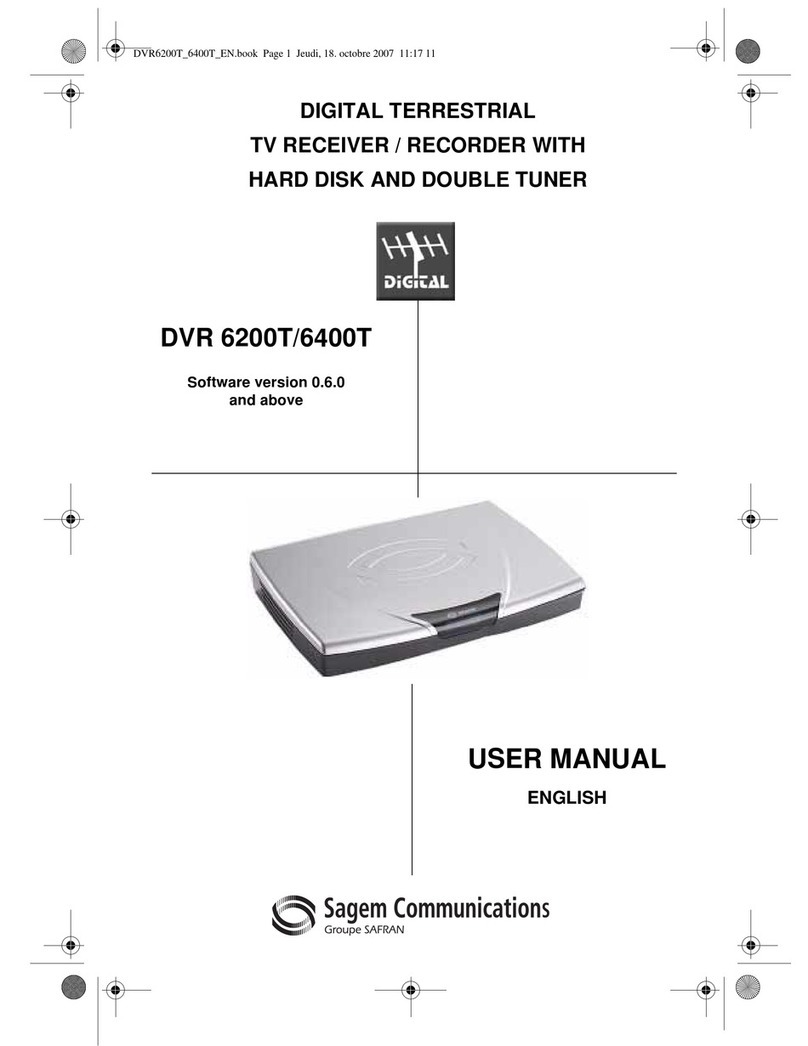Memorex MT1194 User manual

SERVICE MANUAL
MT1194
Design and specifications are subject to change without notice.
COLORTELEVISION RECEIVER
ORIGINAL
MFR'S VERSIONA

6. AVOID AN X-RAY1. KEEP THE NOTICES
5. TAKE CARE TO DEAL WITH THE
CATHODE-RAY TUBE
In the condition that an explosion-proof cathode-
ray tube is set in this equipment, safety is
secured against implosion. However, when
removing it or serving from backward, it is
dangerous to give a shock. Take enough care to
deal with it.
Safety is secured against an X-ray by consider-
ing about the cathode-ray tube and the high
voltage peripheral circuit, etc.
Therefore, when repairing the high voltage pe-
ripheral circuit, use the designated parts and
make sure not modify the circuit.
Repairing except indicates causes rising of high
voltage, and it emits an X-ray from the cathode-
ray tube.
Please include the following informations when you order parts. (Particularly the VERSION LETTER.)
1. MODEL NUMBER and VERSION LETTER
The MODEL NUMBER can be found on the back of each product and the VERSION LETTER can be
found at the end of the SERIAL NUMBER.
2. PART NO. and DESCRIPTION
You can find it in your SERVICE MANUAL.
HOWTO ORDER PARTS
SERVICING NOTICES ON CHECKING
As for the places which need special attentions,
they are indicated with the labels or seals on the
cabinet, chassis and parts. Make sure to keep the
indications and notices in the operation manual.
2. AVOID AN ELECTRIC SHOCK
There is a high voltage part inside. Avoid an
electric shock while the electric current is
flowing.
3. USE THE DESIGNATED PARTS
The parts in this equipment have the specific
characters of incombustibility and withstand
voltage for safety. Therefore, the part which is
replaced should be used the part which has
the same character.
Especially as to the important parts for safety
which is indicated in the circuit diagram or the
table of parts as a mark, the designated
parts must be used.
PUT PARTS AND WIRES IN THE
ORIGINAL POSITION AFTER
ASSEMBLING OR WIRING
4.
There are parts which use the insulation
material such as a tube or tape for safety, or
which are assembled in the condition that
these do not contact with the printed board.
The inside wiring is designed not to get closer
to the pyrogenic parts and high voltage parts.
Therefore, put these parts in the original
positions.
7.PERFORM A SAFETY CHECK AFTER
SERVICING
Confirm that the screws, parts and wiring which
were removed in order to service are put in the
original positions, or whether there are the
portions which are deteriorated around the
serviced places serviced or not. Check the
insulation between the antenna terminal or
external metal and the AC cord plug blades.
And be sure the safety of that.
(INSULATION CHECK PROCEDURE)
1.
2.
3.
4.
Unplug the plug from the AC outlet.
Remove the antenna terminal on TV and turn
on the TV.
Insulation resistance between the cord plug
terminals and the eternal exposure metal
[Note 2] should be more than 1M ohm by
using the 500V insulation resistance meter
[Note 1].
If the insulation resistance is less than 1M
ohm, the inspection repair should be
required.
[Note 1]
If you have not the 500V insulation
resistance meter, use a Tester.
[Note 2]
External exposure metal: Antenna terminal
A1-1
Inferior silicon grease can damage IC's and transistors.
When replacing an IC's or transistors, use only specified silicon grease (YG6260M).
Remove all old silicon before applying new silicon.
IMPORTANT

A1-1
A1-1
A1-1
A2-1
A3-1~A3-4
B1-1
B2-1, B2-2
C-1
C-1
C-2
D-1~D-4
E-1, E-2
F-1~F-4
G-1, G-2
G-3, G-4
G-5, G-6
G-7, G-8
H-1, H-2
I-1
J1-1
J2-1, J2-2
CONTENTS
A2-1
SERVICING NOTICES ON CHECKING..........................................................................................................
HOW TO ORDER PARTS ...............................................................................................................................
IMPORTANT....................................................................................................................................................
CONTENTS .....................................................................................................................................................
GENERAL SPECIFICATIONS ........................................................................................................................
DISASSEMBLY INSTRUCTIONS
1. REMOVAL OF ANODE CAP .................................................................................................................
2. REMOVAL AND INSTALLATION OF FLAT PACKAGE IC ...................................................................
SERVICE MODE LIST.....................................................................................................................................
CONFIRMATION OF HOURS USED ..............................................................................................................
WHEN REPLACING EEPROM (MEMORY) IC ...............................................................................................
ELECTRICAL ADJUSTMENTS .......................................................................................................................
BLOCK DIAGRAM ...........................................................................................................................................
PRINTED CIRCUIT BOARDS
MAIN/CRT....................................................................................................................................................
SCHEMATIC DIAGRAMS
MICON/CHROMA/TUNER...........................................................................................................................
TV POWER ..................................................................................................................................................
DEFLECTION/CRT ......................................................................................................................................
SOUND/AV ..................................................................................................................................................
WAVEFORMS ..................................................................................................................................................
MECHANICAL EXPLODED VIEW ...................................................................................................................
MECHANICAL REPLACEMENT PARTS LIST ...............................................................................................
ELECTRICAL REPLACEMENT PARTS LIST .................................................................................................

GENERAL SPECIFICATIONS
G-1 TV CRT CRT Size / Visual Size 19 inch / 480.0mmV
System CRT Type Normal
Deflection 90 degree
Magnetic Field BV/BH +0.45G/0.18G
Color System NTSC
Speaker 1Speaker
Position Bottom
Size 3 Inch
Impedance 8 ohm
Sound Output MAX 1.5 W
10%(Typical) 1.0 W
NTSC3.58+4.43 /PAL60Hz No
G-2 Tuning Broadcasting System US System M
System Tuner and System 1Tuner
Receive CH Destination USA(W/ CATV)
Tuning System F-Synth
Input Impedance VHF/UHF 75 ohm
2 - 69, 4A, A-5 - A-1,
CH Coverage A - I, J - W, W+1 - W+84
Intermediate Picture(FP) 45.75MHz
Frequency Sound(FS) 41.25MHz
FP-FS 4.50MHz
Preset CH No
Stereo/Dual TV Sound No
Tuner Sound Muting Yes
G-3 Power Power Source AC 120V AC 60Hz
DC
Power Consumption at AC 73 W at AC 120 V 60 Hz
Stand by (at AC) 5 W at AC 120 V 60 Hz
Per Year -- kWh/Year
Protector Power Fuse Yes
Safety Circuit Yes
IC Protector(Micro Fuse) No
G-4 Regulation Safety UL
Radiation FCC
X-Radiation DHHS
G-5 Temperature Operation +
5
o
C
~ +4
0
o
C
Storage -2
0
o
C
~ +
60
o
C
G-6 Operating Humidity Less than 80% RH
G-7 On Screen Menu Yes
Display Menu Type Character
Picture Yes
Contrast Yes
Brightness Yes
Color Yes
Tint Yes
Sharpness Yes
Audio No
Bass No
Treble No
Balance No
BBE On/Off No
Stable Sound On/Off No
CH Set Up Yes
TV/CATV Yes
Auto CH Memory Yes
Add/ Delete Yes
Language Yes
V-chip Yes
CH Label No
Favorite CH No
Color Stream DVD/DTV No
Control Level Yes
Volume Yes
Brightness Yes
Contrast Yes
Color Yes
Tint Yes
Sharpness Yes
Tuning No
Bass No
Treble No
Balance No
Back Light No
Stereo,Audio Output,SAP No
Video Yes
A3-1

GENERAL SPECIFICATIONS
Color Stream No
Channel(TV/Cable) Yes
CH Label No
Sleep Timer Yes
Sound Mute Yes
V-chip Rating Yes
G-8 OSD Language English French Spanish
G-9 Clock and Sleep Timer Max Time 120 Min
Timer Step 10 Min
On/Off Timer Program(On Timer / Off Timer) No
Wake Up Timer No
Timer Back-up (at Power Off Mode) more than -- Min Sec
G-10 Remote Unit RC-DW
Control Glow in Dark Remocon No
Format NEC
Custom Code 86-05 h
Power Source Voltage(D.C) 3V
UM size x pcs UM-4 x 2 pcs
Total Keys 27 Keys
Keys Power Yes
1 Yes
2 Yes
3 Yes
4 Yes
5 Yes
6 Yes
7 Yes
8 Yes
9 Yes
0 Yes
100 No
CH Up Yes
CH Down Yes
Volume Up Yes
Volume Down Yes
TV/Caption/Text Yes
CH1/CH2 Yes
TV/Video(TV/AV) Yes
CH RTN/CH ENT(Quick View) Yes
Sleep Yes
RE Call(Call) Yes
Reset Yes
Menu Yes
Enter Yes
Mute Yes
Exit No
MTS(Audio Select) No
Set + Yes
Set - Yes
Multi Brand Keys CH Up(VCR) No
CH Down(VCR) No
Pause/Still No
TV/VCR(VCR) No
Code No
FF No
Rew No
Rec No
Play No
Stop No
TV No
VCR No
Cable No
G-11 Features Auto Degauss Yes
Auto Shut Off Yes
Canal+ No
CATV Yes
Anti-theft No
Rental No
Memory(Last CH) Yes
Memory(Last Volume) Yes
V-Chip Yes
Type USA,ORION Type
BBE No
Auto Search No
CH Allocation No
SAP No
A3-2

GENERAL SPECIFICATIONS
Channel Lock No
Just Clock Function No
Game Position No
CH Label No
VM Circuit No
Full OSD No
Premiere No
Comb Filter No
Lines
Auto CH Memory Yes
Hotel Lock No
Closed Caption Yes
Stable Sound No
Energy Star No
Power On Memory No
Favorite CH No
G-12 Accessories Owner's Manual Language English / Spanish
w/Guarantee Card Yes
Remote Control Unit Yes
Rod Antenna No
Poles
Terminal
Loop Antenna No
Terminal
U/V Mixer No
DC Car Cord (Center+) No
Guarantee Card No
Warning Sheet No
Circuit Diagram No
Antenna Change Plug No
Service Facility List No
Important Safeguard No
Dew/AHC Caution Sheet No
AC Plug Adapter No
Quick Set-up Sheet No
Battery No
UM size x pcs
OEM Brand No
AC Cord No
AV Cord (2Pin-1Pin) No
Registration Card No
PTB Sheet No
300 ohm to 75 ohm Antenna Adapter No
G-13 Interface Switch Front Power Yes
System Select No
Main Power SW No
Sub Power No
Channel Up/Reset Yes
Channel Down/Enter Yes
Volume Up/Set Up Yes
Volume Down/Set Down Yes
MENU=Volume Up+Volume Down Yes
Rear AC/DC No
TV/CATV Selector No
Degauss No
Main Power SW No
Indicator Power No
Stand-by No
On Timer No
Terminals Front Video Input RCA
Audio Input RCA x 1
Other Terminal No
Rear Video Input(Rear1) No
Video Input(Rear2) No
Audio Input(Rear1) No
Audio Input(Rear2) No
Video Output No
Audio Output No
Euro Scart No
Color Stream No
Diversity No
Ext Speaker No
DC Jack 12V(Center +) No
VHF/UHF Antenna Input F Type
AC Outlet No
G-14 Set Size Approx. W x D x H (mm) 488 x 465 x 416
G-15 Weight Net (Approx.) 17.5kg ( 38.6 lbs)
A3-3

GENERAL SPECIFICATIONS
Gross (Approx.) 20.0kg ( 44.1lbs)
G-16 Carton Master Carton No
Content ---- Sets
Material -- /--
Dimensions W x D x H(mm) -- x -- x --
Description of Origin No
Gift Box Yes
Material Double/Brown
Dimensions W x D x H(mm) 546 x 526 x 472
Design As per Buyer's
Description of Origin Yes
Drop Test Natural Dropping At 1 Corner / 3 Edges / 6
Surfaces
Height (cm) 46
Container Stuffing 436 Sets/40' container
G-17 Cabinet Material Cabinet Cabinet Front PS 94V0 DECABROM
Cabinet Rear PS 94V0 DECABROM
PCB Non-Halogen Demand No
Eyelet Demand No
G-18 Environment Pb Free Lead-free Solder No
Other No
Cd Free No
A3-4

1. REMOVAL OF ANODE CAP
Read the following NOTED items before starting work.
After turning the power off there might still be a potential
voltage that is very dangerous. When removing the
Anode Cap, make sure to discharge the Anode Cap's
potential voltage.
Do not use pliers to loosen or tighten the Anode Cap
terminal, this may cause the spring to be damaged.
REMOVAL
1. Follow the steps as follows to discharge the Anode Cap.
(Refer to Fig. 1-1.)
Connect one end of an Alligator Clip to the metal part of
a flat-blade screwdriver and the other end to ground.
While holding the plastic part of the insulated screwdriver,
touch the support of the Anode with the tip of the
screwdriver.
A cracking noise will be heard as the voltage is discharged.
Flip up the sides of the Rubber Cap in the direction of the
arrow and remove one side of the support.
(Refer to Fig. 1-2.)
2.
GND on the CRT
Screwdriver
Alligator Clip
Support CRT
GND on the CRT
Rubber Cap
CRT Support Fig. 1-2
3. After one side is removed, pull in the opposite direction to
remove the other.
NOTE
Take care not to damage the Rubber Cap.
INSTALLATION
1. Clean the spot where the cap was located with a small
amount of alcohol. (Refer to Fig. 1-3.)
Location of Anode Cap
NOTE
Confirm that there is no dirt, dust, etc. at the spot where
the cap was located.
2.
3.
Arrange the wire of the Anode Cap and make sure the
wire is not twisted.
Turn over the Rubber Cap. (Refer to Fig. 1-4.)
4. Insert one end of the Anode Support into the anode button,
then the other as shown in Fig. 1-5.
5.
6. Confirm that the Support is securely connected.
Put on the Rubber Cap without moving any parts.
CRT Support
DISASSEMBLY INSTRUCTIONS
Fig. 1-3
Fig. 1-4
Fig. 1-5
*
*
Fig. 1-1
B1-1

B2-1
Masking Tape
(Cotton Tape)
DISASSEMBLY INSTRUCTIONS
2.
REMOVAL
IC
Put the Masking Tape (cotton tape) around the Flat
Package IC to protect other parts from any damage.
(Refer to Fig. 2-1.)
1.
Fig. 2-1
NOTE
REMOVAL AND INSTALLATION OF
FLAT PACKAGE IC
Some ICs on the PCB are affixed with glue, so be
careful not to break or damage the foil of each IC
leads or solder lands under the IC when removing it.
NOTE
Masking is carried out on all the parts located within
10 mm distance from IC leads.
Blower type IC
desoldering machine
IC
Heat the IC leads using a blower type IC desoldering
machine. (Refer to Fig. 2-2.)
2.
Fig. 2-2
NOTE
Do not add the rotating and the back and forth
directions force on the IC, until IC can move back and
forth easily after desoldering the IC leads completely.
When IC starts moving back and forth easily after
desoldering completely, pickup the corner of the IC using
a tweezers and remove the IC by moving with the IC
desoldering machine. (Refer to Fig. 2-3.)
3.
Blower type IC
desoldering
machine
IC Fig. 2-3
Tweezers
Peel off the Masking Tape.4.
Absorb the solder left on the pattern using the Braided
Shield Wire. (Refer to Fig. 2-4.)
5.
NOTE
Do not move the Braided Shield Wire in the vertical
direction towards the IC pattern.
Braided Shield Wire
Soldering Iron
Fig. 2-4
IC pattern

B2-2
DISASSEMBLY INSTRUCTIONS
Supply soldering
from upper position
to lower position
IC
Supply the solder from the upper position of IC leads
sliding to the lower position of the IC leads.
(Refer to Fig. 2-6.)
2.
Fig. 2-6
Soldering IronSolder
IC
Absorb the solder left on the lead using the Braided
Shield Wire. (Refer to Fig. 2-7.)
3.
Fig. 2-7
Soldering Iron
Braided Shield Wire
NOTE
Do not absorb the solder to excess.
IC
When bridge-soldering between terminals and/or the
soldering amount are not enough, resolder using a Thin-
tip Soldering Iron. (Refer to Fig. 2-8.)
4.
Fig. 2-8
Thin-tip Soldering Iron
NOTE
When the IC leads are bent during soldering and/or
repairing, do not repair the bending of leads. If the
bending of leads are repaired, the pattern may be
damaged. So, be always sure to replace the IC in this
case.
Finally, confirm the soldering status on four sides of the
IC using a magnifying glass.
Confirm that no abnormality is found on the soldering
position and installation position of the parts around the
IC. If some abnormality is found, correct by resoldering.
5.
Solder temporarily
Soldering Iron
INSTALLATION
Take care of the polarity of new IC and then install the
new IC fitting on the printed circuit pattern. Then solder
each lead on the diagonal positions of IC temporarily.
(Refer to Fig. 2-5.)
1.
Fig. 2-5
Solder temporarily

C-1
SERVICE MODE LIST
This unit provided with the following SERVICE MODES so you can repair, examine and adjust easily.
To enter the Service Mode, press both set key and remote control key for more than 1 second.
Set Key Remocon Key Operations
VOL. (-) MIN 0Releasing of V-CHIP PASSWORD.
VOL. (-) MIN 1 Initialization of the factory.
NOTE: Do not use this for the normal servicing.
If you set a factory initialization, the memories are reser such as the clock
setting, the cheannel setting, the POWER ON total hours, and PLAY/REC
total hours.
VOL. (-) MIN 6
POWER ON total hours is displayed on the screen.
Refer to the "CONFIRMATION OF HOURS USED".
Can be checked of the INITIAL DATA of MEMORY IC.
Refer to the "WHEN REPLACING EEPROM (MEMORY) IC".
VOL. (-) MIN 8 Writing of EEPROM initial data.
NOTE: Do not use this for the normal servicing.
VOL. (-) MIN Display of the Adjustment MENU on the screen.
Refer to the "ELECTRICAL ADJUSTMENT" (On-Screen Display Adjustment).
9
CONFIRMATION OF HOURS USED
POWER ON total hours can be checked on the screen. Total hours are displayed in 16 system of notation.
NOTE: If you set a factory initialization, the total hours is reset to "0".
1.
2.
3.
Set the VOLUME to minimum.
Press both VOL. DOWN button on the set and Channel
button (6) on the remote control for more than 2 second.
After the confirmation of using hours, turn off the power.
FIG. 1
Initial setting content of MEMORY IC.
POWER ON total hours.
= (16 x 16 x 16 x thousands digit value)
+ (16 x 16 x hundreds digit value)
+ (16 x tens digit value)
+ (ones digit value)
ADDRESS DATA
INIT 00 50
CRT ON 0010

WHEN REPLACING EEPROM (MEMORY) IC
If a service repair is undertaken where it has been required to change the MEMORY IC, the following steps should be taken to
ensure correct data settings while making reference to TABLE 1.
Table 1
+9
+2
INI +0 +1 +3 +4 +5 +6 +7
00
+8 +A
07 B3 24 79 31 00 0050 04 EB 47
+B +C +D +E +F
05 10 D5 00 07
1.
2. Enter DATA SET mode by setting VOLUME to minimum.
While holding down VOLUME button on front cabinet, press key 6 on remote control for more than 2 seconds.
ADDRESS and DATA should appear as FIG 1.
3.
4.
5.
6.
7.
8.
9.
10.
11.
The unit will now have the correct DATA for the new MEMORY IC.
ADDRESS is now selected and should "blink". Using the VOL. +/- button on the remote, step through the ADDRESS until
required ADDRESS to be changed is reached.
Press ENTER to select DATA. When DATA is selected, it will "blink".
Again, step through the DATA using VOL. +/- button until required DATA value has been selected.
Pressing ENTER will take you back to ADDRESS for further selection if necessary.
Repeat steps 3 to 6 until all data has been checked.
When satisfied correct DATA has been entered, turn POWER off (return to STANDBY MODE) to finish DATA input.
After the data input, set to the initializing of shipping.
Turn POWER on.
While holding down VOLUME button on front cabinet, press key 1 on remote control for more than 2 seconds.
After the finishing of the initializing of shipping, the unit will turn off automatically.
Fig. 1
ADDRESS DATA
INIT 00 50
CRT ON 0010
C-2

D-1
ELECTRICAL ADJUSTMENTS
1.
Read and perform these adjustments when repairing the
circuits or replacing electrical parts or PCB assemblies.
2. BASIC ADJUSTMENTSBEFORE MAKING ELECTRICAL
ADJUSTMENTS 2-1: CUT OFF
1.
2.
3.
4.
Adjust the unit to the following settings.
R.DRIVE=10, B.DRIVE=10, R.BIAS=64, G.BIAS=64,
B.BIAS=64, BRI.CENT=105, CONT.MAX=65.
Place the set with Aging Test for more than 15 minutes.
Activate the adjustment mode display of Fig. 1-1 and
press the channel button (01) on the remote control to
select "CUT OFF".
Adjust the Screen Volume until a dim raster is obtained.
2-2: FOCUS
1.
2.
3.
Receive the monoscope pattern.
Turn the Focus Volume fully counterclockwise once.
Adjust the Focus Volume until picture is distinct.
2-3: WHITE BALANCE
NOTE: Adjust after performing CUT OFF adjustment.
Place the set with Aging Test for more than 10 minutes.
Receive the white 100% signal from the Pattern
Generator.
Using the adjustment control, set the brightness and
contrast to normal position.
Activate the adjustment mode display of Fig. 1-1 and
press the channel button (10) on the remote control to
select "R.BIAS".
Using the VOL. UP/DOWN button on the remote control,
adjust the R.BIAS.
Press the CH. UP/DOWN button on the remote control to
select the "R.DRIVE", "B.DRIVE", "G.BIAS" or "B.BIAS".
Using the VOL. UP/DOWN button on the remote control,
adjust the R.DRIVE, B.DRIVE, G.BIAS or B.BIAS.
Perform the above adjustments 6 and 7 until the white
color is looked like a white.
1.
2.
3.
4.
5.
6.
7.
8.
2-4: SUB TINT/SUB COLOR
1.
2.
3.
4.
5.
6.
7.
8.
9.
Receive the color bar pattern.
Connect the oscilloscope to TP023.
Activate the adjustment mode display of Fig. 1-1 and
press the channel button (22) on the remote control to
select "TINT".
Press the VOL. UP/DOWN button on the remote control
until the section "A" becomes as straight line
(Refer to Fig. 2-1)
Connect the oscilloscope to TP022.
Activate the adjustment mode display of Fig. 1-1 and
press the channel button (19) on the remote control to
select "COL.CENT".
Press the VOL. UP/DOWN button on the remote control
until the red color level is adjusted to 110 ±10% of the
white level. (Refer to Fig. 2-2)
Receive the color bar pattern. (Audio Video Input)
Press the TV/AV button on the remote control to set to
the AV mode. Then perform the above adjustments 2~7
CAUTION
Use an isolation transformer when performing any service
on this chassis.
Before removing the anode cap, discharge electricity
because it contains high voltage.
When removing a PCB or related component, after
unfastening or changing a wire, be sure to put the wire
back in its original position.
When you exchange IC and Transistor for a heat sink,
apply the silicon grease (YG6260M) on the contract
section of the heat sink, Before applying new silicon
grease, remove all the old silicon grease. (Old grease
may cause damages to the IC and Transistor.)
•
•
•
•
1. Synchro Scope
2. Digital Voltmeter
3. Pattern Generator
Prepare the following measurement tools for electrical
adjustments.
On-Screen Display Adjustment
In the condition of NO indication on the screen.
Press the VOL. DOWN button on the set and the
Channel button (9) on the remote control for more than
1 second to appear the adjustment mode on the screen
as shown in Fig. 1-1.
1.
Fig. 1-1
Use the Channel UP/DOWN button or Channel button
(0-9) on the remote control to select the options shown
in Fig. 1-2.
Press the MENU button on the remote control to end
the adjustments.
2.
3.
TV
00 OSD H 28
FUNCTION
OSD H
CUT OFF
H.VCO
H.PHASE
V.SIZE
V.SHIFT
R.DRIVE
B.DRIVE
R.BIAS
G.BIAS
B.BIAS
BRIGHT CENT
BRIGHT MAX
BRIGHT MIN
NO.
00
01
04
05
06
07
08
09
10
11
12
13
14
15 Fig. 1-2
FUNCTION
CONTRAST CENT
CONTRAST MAX
CONTRAST MIN
COLOR CENT
COLOR MAX
COLOR MIN
TINT
SHARPNESS
FM LEVEL
LEVEL
SEPARATION 1
SEPARATION 2
TEST MONO
TEST STEREO
NO.
16
17
18
19
20
21
22
23
24
25
26
27
28
29

D-2
ELECTRICAL ADJUSTMENTS
2-8: OSD HORIZONTAL
1.
2. Activate the adjustment mode display of Fig. 1-1.
Press the VOL. UP/DOWN button on the remote
control until the difference of A and B becomes
minimum. (Refer to Fig. 2-3)
Fig. 2-3
Receive an 70dB monoscope pattern.
Using the adjustment control, set the brightness and
contrast to normal position.
Activate the adjustment mode display of Fig. 1-1 and
press the channel button (13) on the remote control to
select "BRI.CENT".
Press the VOL. UP/DOWN button on the remote control
until the white 10% is starting to be visible.
Press the TV/AV button on the remote to set to the
AV mode. Then perform the above adjustment 2~4.
1.
2.
3.
4.
5.
2-9: SUB BRIGHTNESS
Fig. 2-1
Fig. 2-2
2-5: HORIZONTAL PHASE
1.
2.
3.
4.
Receive the monoscope pattern.
Using the adjustment control, set the brightness and
contrast to normal position.
Activate the adjustment mode display of Fig. 1-1 and
press the channel button (05) on the remote control to
select "H.PHAS".
Press the VOL. UP/DOWN button on the remote
control until the SHIFT quantity of the OVER SCAN on
right and left becomes minimum.
2-6: VERTICAL SIZE
1.
2.
3.
4.
Receive the crosshatch signal from the Pattern
Generator.
Activate the adjustment mode display of Fig. 1-1 and
press the channel button (06) on the remote control to
select "V.SIZE".
Press the VOL. UP/DOWN button on the remote control
until the SHIFT quantity of the OVER SCAN on upside
and downside becomes 10 ±2%.
Receive a broadcast and check if the picture is normal.
NOTE: Adjust after performing adjustments in section 2-5
2-7: VERTICAL SHIFT
1.
2.
3.
Receive the crosshatch signal from the Pattern
Generator.
Activate the adjustment mode display of Fig. 1-1
and press the channel button (07) on the remote
control to select "V.SFT".
Press the VOL. UP/DOWN button on the remote
control until the horizontal line becomes fit to the
notch of the shadow mask.
NOTE: Adjust after performing adjustments in section 2-6
"A"
Red 110%
Receive an 70dB the color bar pattern.
Activate the adjustment mode display of Fig. 1-1
press the channel button (17) on the remote control
to select "CONT.MAX".
Press the VOL. UP/DOWN button on the remote control
until the contrast step No. becomes "60".
Press the TV/AV button on the remote to set to the
AV mode. Then perform the above adjustment 2, 3.
1.
2.
3.
4.
2-10: SUB CONTRAST
BA
TV
00 OSD H 28
2-11: Confirmation of Fixed Value (Step No.)
Please check if the fixed values of the each adjustment
items are set correctly referring below.
RF
04
150
45
45
15
74
00
45
00
00
00
00
00
00
NO.
04
14
15
16
18
20
21
23
24
25
26
27
28
29
FUNCTION
H VCO
BRIGHT MAX
BRIGHT MIN
CONT CENT
CONT MIN
COLOR MAX
COLOR MIN
SHARPNESS
FE LEVEL
LEVEL
SEPARATION 1
SEPARATION 2
TEST MONO
TEST STEREO
AV
04
150
45
45
15
74
00
45
00
00
00
00
00
00

D-3
ELECTRICAL ADJUSTMENTS
3.
1.
2.
3.
1.
2.
3.
4.
5.
6.
7.
8.
3-2: PURITY
NOTE
Adjust after performing adjustments in section 3-1.
1.
2.
3.
4.
5.
Receive the green raster pattern from color bar
generator.
Adjust the pair of purity magnets to center the
color on the screen.
Adjust the pair of purity magnets so the color at the
ends are equally wide.
Move the deflection yoke backward (to neck side)
slowly, and stop it at the position when the whole
screen is green.
Confirm red and blue colors.
Adjust the slant of the deflection yoke while watching the
screen, then tighten the fixing screw.
DEFLECTION YOKE
DEFLECTION YOKE SCREW
MAGNET SCREW
PURITY MAGNETS
6 POLE MAGNETS
4 POLE MAGNETS
Fig. 3-1
PURITY AND CONVERGENCE
ADJUSTMENTS
NOTE
3-1: STATIC CONVERGENCE (ROUGH ADJUSTMENT)
Tighten the screw for the magnet. Refer to the adjusted
CRT for the position. (Refer to Fig. 3-1)
If the deflection yoke and magnet are in one body,
untighten the screw for the body.
Receive the green raster pattern from the color bar
generator.
Slide the deflection yoke until it touches the funnel
side of the CRT.
Adjust center of screen to green, with red and blue on the
sides, using the pair of purity magnets.
Switch the color bar generator from the green raster
pattern to the crosshatch pattern.
Combine red and blue of the 3 color crosshatch pattern
on the center of the screen by adjusting the pair of
4 pole magnets.
Combine red/blue (magenta) and green by adjusting the
pair of 6 pole magnets.
Adjust the crosshatch pattern to change to white
by repeating steps 6 and 7.
Turn the unit on and let it warm up for at least 30
minutes before performing the following adjustments.
Place the CRT surface facing east or west to reduce the
terrestrial magnetism.
Turn ON the unit and demagnetize with a Degauss Coil.
3-3: STATIC CONVERGENCE
1.
2.
3.
3-4: DYNAMIC CONVERGENCE
Adjust after performing adjustments in section 3-3.
1.
2.
Adjust the differences around the screen by moving
the deflection yoke upward/downward and right/left.
(Refer to Fig. 3-2-a)
Insert three wedges between the deflection yoke
and
CRT funnel to fix the deflection yoke.
(Refer to Fig. 3-2-b)
R G B
R
G
B
Fig. 3-2-a
WEDGE WEDGE
WEDGE
WEDGE POSITION
Fig. 3-2-b
R G B
R
G
B
Receive the crosshatch pattern from the color bar
generator.
Combine red and blue of the 3 color crosshatch pattern
on the center of the screen by adjusting the pair of
4 pole magnets.
Combine red/blue (magenta) and green by adjusting the
pair of 6 pole magnets.
UPWARD/DOWNWARD SLANT RIGHT/LEFT SLANT
Adjust after performing adjustments in section 3-2.
NOTE
NOTE

ELECTRICAL ADJUSTMENTS
4. ELECTRICAL ADJUSTMENT PARTS LOCATION GUIDE (WIRING CONNECTION)
CP803A
CP802A
TU001
S501A
S501B
FB401
CD501
AC IC
CP401
CP802B
CP806
CD803
CRT PCB
MAIN PCB
CRT
CD101A
CD101B
SPEAKER
CD802
R807
R803
J801
TP023
TP022
CP801
CRT
CD801
CP803B
CRT
CP502
L503
D-4

OSD
BLOCK DIAGRAM
70
68
67
73
66 ATT
RGB Proc.2
OSD SW
CONTRAST BRIGHTNESS
I/O
IIC
TIM
INT
PWM
AD
MCU
CLK
VCXO
RGB OUTPUT
Stage DRIVE
CUT OFF
HV BLK
Ver.Proc.
Ver SYNC SEP
Ver.COUNT DOWN
V RAMP
20
21
IC1001 AN7511
Q801
RED OUT
Q802
GREEN OUT
Q803
BLUE OUT
Q402
H. DRIVE
Q401
H. OUTPUT
26
SOUND AMP
IC
48
Q607
H-CTL
SPEAKER
SP1001
52
51
50
34
45
46
9
HV
F
S
FB401
10
1
2
3
CRT
397
RGB
Heater
F8
4
PUMP UP
AMP
+
-
75
26
V-OUT IC
IC401 LA78040N-E
VCC
RGB Proc.1
RGB MATRIX
COLOR CONT
3837
26
27
57
58 16
Hor.Proc.
SYNC SEPA/Hor. VCO
Hor.COUNT DOWN
AFC-1/H COINCIDENT
AFC-2 H PHASE
1
2
DY
3
1
4
2L501
AC IN
F501
Q507
FEED BACK
T502
4
8
13
FEED BACK
SW
Q502
BUFFER
6
L503
DEGAUSS COIL
6
5MEMORY IC
IC199
S-24C02BFJ-TB
SDA SCL
VOL. DOWN
CH. DOWN
VOL. UP
CH. UP
X601
3.579545MHz
TU001
10 13
11 12 17
OS101
1
16
Q505 MICON/CHROMA IC
IC101 OEC7091B
Chroma Proc.
ACC/C-BPF
APC/KILLER
TINT/DEMO
P. FAIL
IC501
PS2561AL1-1-V(W)
78
J703
2
J702
ROM
RAM IIC BUS
DECODER
56
Q501
POWER AMP D501~D504
RECTIFIER
TH501
Video Proc.
C-TRAP/Y DELAY
SHARPNESS
BLACK
STRETCHY MUTE
V801
E-1 E-2

TCD460A
TMD604A
Q602
Q606
R605
D604
D603
W851
IC1001
D001
W053
W055
R621
D606
Q607
R617
R109
Q601 Q603
W040
R615
R613
R614
R611
W051
W041
W060
CP802A
J703 J702
R002
SW101 SW102 SW103 SW104
R505
R449
R448
W038
W039
C427
R410
D403
R424
C414
IC401
W027
C437
R408
D412
D509
D508
HS501
C508_1
TH501_1
C519
C446
W020
R504
TP401
R519
D512
FH501
FH502 F501
S501B
S501A
R518
IC501
D511
R515
R513
D528
R512
D516
CP401
C403
R514
HS402
R520
R506
R503
Q502
Q501
R542
CP502
C521
D410
B504
B501
R517
R422
D513 D505
D506
D405
AFC
HS401
COL
8V
ABL
GND
25V
12V
180V
HEATER
R538
C434
Q507
R417
C516
D514
R607
W061
W052
W028
W029
D522
R001
R445
R528
R1001
W026
W011
W043
W044
W045
R110
R113
R112
W057
W058
W017
R421
R446
W068
D406
R409
W010
T401
R620
Q402
C518
C418
C506_1
W073
W034
R603
W024
W023
W062
W007
W050
W009
TP024
CP806
C819
R807_2
R803_2
CP802B
TP023
TP022
C801
W048
W046
W032
W030
R123
W016
R423
C502
C503
R806
R802
SW105
W069
R143
W816
R427
Q401
R501
W004
W049
W019
W847
W848
D515
W803
R447
C410
W025
C511
R130
R106
R105
R116
R119
W067
W001
R522
W042
D507
R502
D521
C509
C435
C406
W064
D404
D408
D411
W003
W008
W056
R601
R604
X601
R403
R508
R415
D501
D502
D503
D504
CP801_2
OS101
CP803B
CP803A
L801
W801
CD101A
CD101B
C443
C515
C624
D510
L501
D602
TU001
W013
W014
R402
C402
W018
W066
W845
W006
C440
T502
CP601
D517
R404
W015
L101
W070
L001
C442
W021
C526_1
FB401
C630_1
C632_1
C1005_1
R804_1
C417_1
C514_1
C628_1
C621_1
C617_1
C103_1
C601_1
C623_1
C123_1
C606_1
R629_1
C633_1
C610_1
W836
W831
W832
W819
W805
C118_1
C510_1
R511_1
R429
CD501
C517
C505
R509
D409
R805_2
R407
R416
W807
W817
C422_1
R500
J801
R608
R616
Q803_1
Q802_1 Q801_1
CD803A
CD803B
CD802A
CD802B
PRINTED CIRCUIT BOARDS
MAIN/CRT (INSERTED PARTS)
SOLDER SIDE
F-1 F-2
4A125VOR250V
CAUTION
ATTENTION
INFORMATIONPOUR SERVICE DES PIECE
CRITIQUE VOIR AU VERSO.
,
SERVICEFOR INFORMATION ABOUT CRITICAL
COMPONENTS SEE INSIDE BACK COVER.
,

TCD460A
TMD604A
1
25
41
64
C1004
R1003
R004
R610
C101
R618
C102
IC101
R702R703
R128
R126
R101
R420
R419
C501
R125
R609
R115
R1005
R1004
R704
R127
R627
R107
R108
R129
R813
R809
R816
R814
R815
R811
R701
R405
R418
R003
R507
C639
C620 C1001
C607
C608
C1009
C001
R602
C603
R103C611
R104
R120
C602
C105
C107
R102 C104
C108
R606
C622
C605
C113
IC199
C004
C615
C616
R1008
C629_1
C627_1
C604_1
C626_1
C007_1
C407_1
C609_1
C513_2
C808_2
C810_2
C809_2
C641
PRINTED CIRCUIT BOARDS
MAIN/CRT (CHIP MOUNTED PARTS)
SOLDER SIDE
F-3 F-4

ABC D E F GH
ABC D E F GH
2
1
3
4
5
6
7
8
2
1
3
4
5
6
7
8
WAS RECEIVED IN GOOD CONDITION AND PICTURE IS NORMAL.
WITH THE DIGITAL TESTER WHEN THE COLOR BROADCAST
NOTE:THE DC VOLTAGE AT EACH PART WAS MEASURED
C607
1F
C608
1F
C616
1F
C615
1F
C609_1
0.01 B
C104
0.01 B
C611
1F
C629_1
0.01 B
C007_1
0.022 B
C627_1
0.01 B
C626_1
0.01 B
C624
1TF
C101
0.01 B
C620
0.01 B
C639
0.01 F
C004
0.022 F
C113
560P B
C102
0.01 B
C105 470P B
C107 220P B
C603
22P CH
C001
0.01 F
C622
1F
C605
1F
C641
0.001 B
C108
0.001 B
C602
0.1 F
C604_1
0.022 B
C610_1
4716V YK
C606_1
1006.3V YK
C103_1
4706.3V YK
C630_1
47010V YK
C632_1
47010V YK
C628_1
150V KA
C118_1
4706.3V YK
C123_1
1050V YK
C623_1
2.250V KA
C633_1
1050V YK
C601_1
150V KA
C617_1
10010V YK
C621_1
4716V YK
R112
2.2K 1/4W R113
2.2K 1/4W
R601
8.2K
1/4W
R103 1K
R102
1K
R609
120K
R611
10K 1/4W
R002
15K 1/2W
R610
12K
R613 100 1/4W
R614 100 1/4W
R603
120 1/2W
R607
100 1/4W
R615 100 1/4W
R608
1K 1/4W
R616 1K 1/4W
R618
22K
R617
47K 1/4W
R620
1K 1/2W
R003
100
R004
100
R104
1M
R120
470
R127
1K
R107
100
R108
100
R106
4.7K
1/4W
R129
47K
R119
22K 1/4W
R621
220 1/4W
R109 10K 1/4W
R110 10K 1/4W
R605
220 1/2W
R116
2.2K 1/4W
R115
22K
R123
10K 1/4W
R125
47K
R627
10K
R604
100 1/4W
R128
560 R126
2.7K
R101
560
R602
100
R606
22K
R001
15K 1/2W
R143
10 1/4W
R130
10K 1/4W
R105
4.7K
1/4W
OF PRINTING AND SUBJECT TO CHANGE WITHOUT NOTICE
NOTE:THIS SCHEMATIC DIAGRAM IS THE LATEST AT THE TIME
DANS LA NOMENCLATURE DES PIECES
N’UTILISER QUE CELLS DECRITES
DANGEREUSES AN POINT DE VUE SECURITE
:LES PIECES REPAREES PAR UN ETANT
ATTENTION
:SINCE THESE PARTS MARKED BY
CAUTION
DESCRIBED IN PARTS LIST ONLY
CRITICAL FOR SAFETY,USE ONES
ARE
W836
W816
W801
W805
IC199
S-24C02BFJ-TB
MEMORY IC
1234
5678
TUNER VIDEO SIGNAL
D602
MTZJ8.2B
D604
MTZJ8.2B
D001
MTZJ33B
DEFLECTION SIGNAL
B.SIGNAL
G.SIGNAL
R.SIGNAL
D606
1N4002-PAN
D603
1SS133
Q601
KTC3203_Y
5V REG
Q606
KTC3203_Y
8V REG
Q607
KTC3198
H.CTL
Q602
KTC3203_Y
5V REG
Q603
KTC3203_Y
5V REG
R629_1
22 3W
L101
3.3uH 0305
IC101
OEC7091B
MICON/CHROMA IC
1 101112131415161718192 20 21 22 23 24
25 26 27 28 29
3
30 31 32 33 34 35 36 37 38 39
4
40
414243444546474849
5
50515253545556575859
6
6061626364
6566676869
7
70717273747576777879
8
80
9
SW104
EVQ21505R
VOL DOWN
SW103
EVQ21505R
VOL UP
SW102
EVQ21505R
CH DOWN
SW101
EVQ21505R
CH UP
SW105
EVQ21505R
POWER_ON
X601
100BT3R537
3.579545MHz
CP601
173979-6
1
2
3
4
5
6
L001
3.3uH 0305
TU001
ENG36A01GY
1
10
11
12
13
14
15
16
17
18
19
2
20
21
3
4
5
6
7
8
9
GND
B+
Vout
OS101
KSM-713SY
1
2
3
P.CON+5V
P.CON+5V
H_OUT
H_CTL
ABCL
B.OUT
CLAMP
H_CTL
G.OUT
R.OUT
H_SYNC
V_OUT
GND
V_FEEDBACK
AT+5V
ABCL
H_OUT
P.CON+5V X-RAY
SDA R.OUT
G.OUT
SCL
B.OUT
H_SYNC
AFT
UNREG+12V
KEY1 V_OUT
POWER_FAIL
KEY2 V_FEEDBACK
UNREG+12V
POWER_ON
GND
+B
REMOCON
AUDIO_OUT
AUDIO_MUTE
AUDIO_MUTE
VIDEO_IN2
AUDIO_IN2
X-RAY
AUDIO_OUT
P.CON+5V
IIC_OFF P.CON+5V
TUNER+5V
GND
POWER_FAIL AUDIO_IN2
VIDEO_IN2
TUNER+5V
AT+5V
TU_VIDEO
TU_AUDIO
SCL
AT+5V
SDA
KEY1
KEY2
REMOCON
POWER_ON
AFT
IIC_OFF
TU_AUDIO SDA
SCL
+B
TU_VIDEO
FROM/TO SOUND/AV
FROM TV POWER
G-2G-1
TMD604
PCB010
NC
NC
NC
NC
NC
NC
NC
4.8
0000
4.9 0 4.8
4.9
7.2
4.9
6 MCU VCC
7 TEST0
8 FILT
9 HLT
5 VSS
1 CNVSS
2 XIN
3 XOUT
4 TEST1
11 CVIN
10 VHOLD
12 RESET IN
13 MCU RESET OUT
14 Y SW OUT
15 V/C GND
16 3.58 XTAL
17 C-APC
18 MCU5.7V REG OUT
19 NC
20 CVBS IN3
21 AUDIO IN3
22 V/C VCC
23 MCU TEST
24 CVBS IN2
25 AUDIO IN2
26 CVBS IN1
27 AUDIO IN1
28 5.7V REG OUT
29 C(Y/C) IN
33 MONITOR OUT
32 FSC OUT
31 VREG VCC
30 Y(Y/C) IN
34 AUDIO ATT OUT
37 V RAMP F/B
38 V RAMP OUT
39 V RAMP CAP
40 8.7V REG OUT
Ver SYNC SEP
Ver.COUNT DOWN
V RAMP
Ver.Proc.
Hor.Proc.
SYNC SEPA/Hor.VCO
Hor.COUNT DOWN
AFC-1/H COINCIDENT
AFC-2 H PHASE
PGB OUTPUT Stage
DRIVE
CUT-OFF
HV BLK
IIC BUS
DECODER
OSD
ROM
RAM
CCD
CPU core
VCO
XO
COLOR CONT
RGB MATRIX
RGB Proc.1
RGB Proc.2
OSD SW
CONTRAST
BRIGHTNESS
MCU RESET
Power Manage.
MCU
CLK Y MUTE
BLACK STRETCH
Vldeo Proc.
C-TRAP/YDELAY
SHARPNESS
Chroma Proc.
ACC/C-BPF
APC/KILLER
TINT/DEMO
ATT
VCXO
LPF
6bB AMP
MCU GND
IIC
TIM
AD
PWM
INT
I/O
CLK CONT
P-ON CONT
SDA/SCL
NC
NC
4.8
SCL
SDA
IIC_OFF
GND
NC
NC
35 AUDIO ATT FILTER
41 NC
42 HVCO F/B
43 AFC FILTER
44 DEF GND
45 FBP IN
46 H OUT
47 DEF VCC
48 NC
49 HI VCC
50 R OUT
51 G OUT
52 B OUT
53 ACL
54 NC
55 PROTECT
56 SDA
57 H_CTL
58 SCL
62 DEGAUSS_H
63 STANDBY_H
64 VOLUME
66 AFT
67 KEY1
68 KEY2
71 AV2
72 AV1
73 AUDIO_MUTE
77 SYNC
78 POWER FAIL
80 EXT_MUTE
76 ON_TIMER
60 NC
61 NC
75 IIC_OFF
65 NC
59 NC
70 REMOCON
69 POWER_ON
74 X-RAY
36
NC
NC
NC
4.8
2.4
4.9
4.9
4.9
4.8
0
4.9
4.9
2.8
4.8
0
0
4.8
0
4.9
NC
0
1.9
2.2
5.5
2.2
1.9
8.7
2.8
0.7
3.2
3.5
0
2.6
3.6
4.7
8.6
03.73.401.02.08.04.8008.02.32.22.30.7
00 04.9 4.9 4.9 0 1.0 1.9 0.3 2.7 4.9 4.9 2.7 0 3.3 2.8 5.5 0 2.5 2.2 4.9 0
NC
6
57
3
2
4
1
5.5
8.8
TEST POINT
FROM/TO DEFLECTION/CRT
6.0 5.0
5.6
NC NC
NC
NC
NC
NC
NC
NC
NC
NC
NC
NC
MICON/CHROMA/TUNER SCHEMATIC DIAGRAM
(MAIN PCB)
79 X-RAY_TEST
NC
1.9
11.3
7.9
8.5
0 0 0 0 0 0 4.8 0 4.8
5.5
7.2
5.5
4.9
VSS
E2
E1
E0VCC
MODE
SCL
SDA
4.9
0
Table of contents
Other Memorex TV Receiver manuals


